-

部编人教版四年级下册《琥珀》说课稿
二、说理念:1.在教学中,尊重学生的个性化行为,引导学生在积极主动的思维和情感活动中,自主体验、感悟,注重体验过程。2.课外延伸,发挥学生的创造潜能,激活学生的想象能力,使课内学习与课外发展相得益彰,提高学生的语文素养。三、说目标:1.理解课文内容,根据琥珀的样子推想它的形成过程,体会科学家是怎样进行合理想象的。这也是本文的教学重难点。2.发展学生的合作、探究精神,根据其它的化石推想成因,学习有依据地、合理地进行想象,培养学生的想象能力。3.通过学习,激发学生探索大自然奥秘的兴趣,树立热爱科学的情感。四、说教与学活动步骤:(一)整体把握课文,进入语文实践教师出示文中“琥珀”的图片,学生围绕这块琥珀,说一说课文都写了哪些内容。随着学生的汇报,抓住琥珀的样子与它的价值这一段落,学生进行朗读,发现“想象”和“推测”两个词语,并理解意思。随之和科学家一起合理想象琥珀形成的过程。

部编人教版四年级下册《母鸡》说课稿
今天,我说课的题目是《母鸡》,下面我将从说教材、教法和学法、教学过程、板书设计等几个方面来对本课题进行说课。一、说教材《母鸡》这篇课文是部编版四年级下册的课文,本文记述了一只母鸡关心爱护它的小鸡的事例,抒发了对纯洁无私的母爱的赞美之情根据新课程标准和本文的具体教学内容,结合四年级学生的实际情况,我确定了本课时的教学目标:知识技能目标:1.认识本课12个生字,会写“讨厌”等15个生字。2.正确、流利、有感情地朗读课文。3.了解母鸡的特点,体会作者用词的严谨和伟大的母爱在母鸡身上的具体体现。4.学习课文抓住特点,具体生动描写动物的写法。情感目标:感受伟大的母爱。教学重点:了解母鸡的生活习性及伟大的母爱在母鸡身上的具体体现。教学难点:学习课文,抓住特点,具体生动描写动物的写法
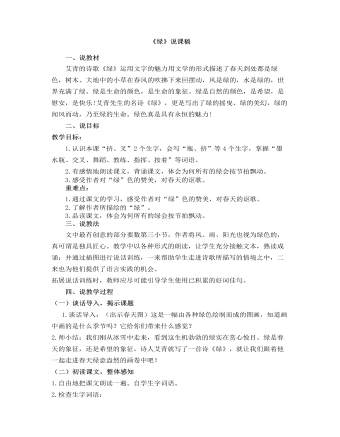
部编人教版四年级下册《绿》 说课稿
二、说目标教学目标:1.认识本课“挤、叉”2个生字,会写“瓶、挤”等4个生字,掌握“墨水瓶、交叉、舞蹈、教练、指挥、按着”等词语。2.有感情地朗读课文,背诵课文,体会为何所有的绿会按节拍飘动。3.感受作者对“绿”色的赞美,对春天的讴歌。重难点:1.通过课文的学习,感受作者对“绿”色的赞美,对春天的讴歌。2.了解作者所描绘的“绿”。3.品读课文,体会为何所有的绿会按节拍飘动。三、说教法文中最有创意的部分要数第三小节,作者将风、雨、阳光也视为绿色的,真可谓是独具匠心。教学中以各种形式的朗读,让学生充分接触文本,熟读成诵;并通过插图进行说话训练,一来帮助学生走进诗歌所描写的情境之中,二来也为他们提供了语言实践的机会。拓展说话训练时,教师应尽可能引导学生使用已积累的好词佳句。
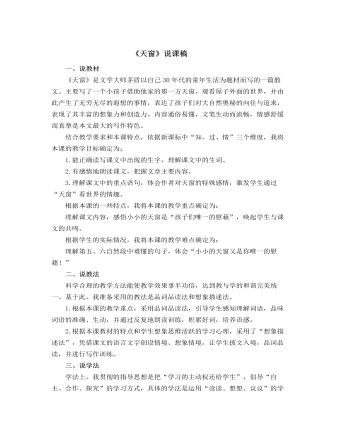
部编人教版四年级下册《天窗》说课稿
二、说教法科学合理的教学方法能使教学效果事半功倍,达到教与学的和谐完美统一。基于此,我准备采用的教法是品词品读法和想象描述法。1.根据本课的教学重点,采用品词品读法,引导学生感知理解词语,品味词语的准确、生动,并通过反复地朗读训练,积累好词,培养语感。2.根据本课教材的特点和学生想象思维活跃的学习心理,采用了“想象描述法”,凭借课文的语言文字创设情境、想象情境,让学生披文入境,品词品读,并进行写作训练。三、说学法学法上,我贯彻的指导思想是把“学习的主动权还给学生”,倡导“自主、合作、探究”的学习方式,具体的学法是运用“读读、想想、议议”的学习方法,通过朗读课文,品词析句、展开联想等多种途径,训练语言表达、思维、朗读的能力,积累规范语言,体味作品的语言美。此外我准备用多媒体手段辅助教学。
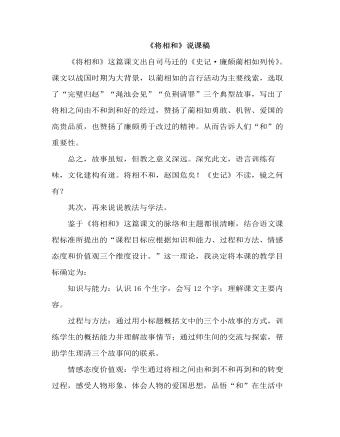
部编人教版五年级上册《将相和》说课稿
鉴于《将相和》这篇课文的脉络和主题都很清晰,结合语文课程标准所提出的“课程目标应根据知识和能力、过程和方法、情感态度和价值观三个维度设计。”这一理论,我决定将本课的教学目标确定为:知识与能力:认识16个生字,会写12个字;理解课文主要内容。过程与方法:通过用小标题概括文中的三个小故事的方式,训练学生的概括能力并理解故事情节;通过师生间的交流与探索,帮助学生理清三个故事间的联系。情感态度价值观:学生通过将相之间由和到不和再到和的转变过程,感受人物形象,体会人物的爱国思想,品悟“和”在生活中的重要性,并以此为跳板,了解中国的“和”文化。教学的重点和难点放在引导学生充分感受文中的人物形象,并且体会到“和”的意义。
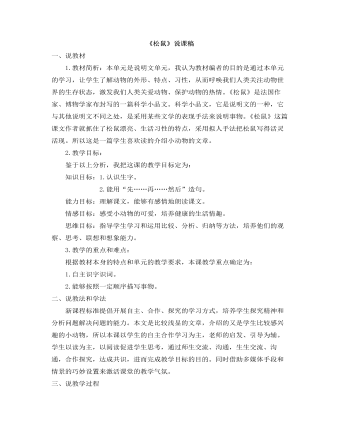
部编人教版五年级上册《 松鼠》说课稿
一、说教材 1.教材简析:本单元是说明文单元,我认为教材编者的目的是通过本单元的学习,让学生了解动物的外形、特点、习性,从而呼唤我们人类关注动物世界的生存状态,激发我们人类关爱动物、保护动物的热情。《松鼠》是法国作家、博物学家布封写的一篇科学小品文。科学小品文,它是说明文的一种,它与其他说明文不同之处,是采用某些文学的表现手法来说明事物。《松鼠》这篇课文作者就抓住了松鼠漂亮、生活习性的特点,采用拟人手法把松鼠写得活灵活现。所以这是一篇学生喜欢读的介绍小动物的文章。2.教学目标:鉴于以上分析,我把这课的教学目标定为:知识目标:1.认识生字。2.能用“先……再……然后”造句。能力目标:理解课文,能够有感情地朗读课文。情感目标:感受小动物的可爱,培养健康的生活情趣。
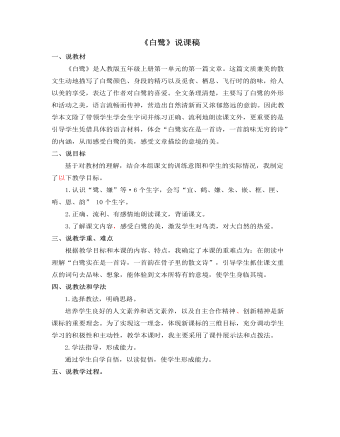
部编人教版五年级上册《白鹭》说课稿
一、说教材《白鹭》是人教版五年级上册第一单元的第一篇文章。这篇文质兼美的散文生动地描写了白鹭颜色、身段的精巧以及觅食、栖息、飞行时的韵味,给人以美的享受,表达了作者对白鹭的喜爱。全文条理清楚,主要写了白鹭的外形和活动之美,语言流畅而传神,营造出自然清新而又浓郁悠远的意韵。因此教学本文除了带领学生学会生字词并练习正确、流利地朗读课文外,更重要的是引导学生凭借具体的语言材料,体会“白鹭实在是一首诗,一首韵味无穷的诗”的内涵,从而感受白鹭的美,感受文章描绘的意境的美。二、说目标基于对教材的理解,结合本组课文的训练意图和学生的实际情况,我制定了以下教学目标。
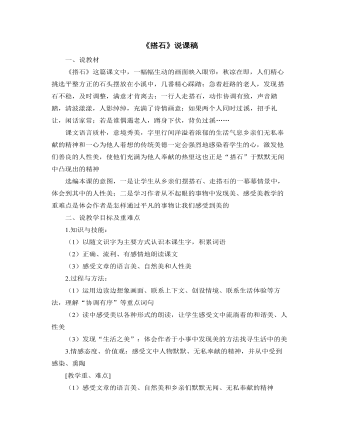
部编人教版五年级上册《搭石》说课稿
一、说教材《搭石》这篇课文中,一幅幅生动的画面映入眼帘:秋凉在即,人们精心挑选平整方正的石头摆放在小溪中,几番精心踩踏;急着赶路的老人,发现搭石不稳,及时调整,满意才肯离去;一行人走搭石,动作协调有致,声音踏踏,清波漾漾,人影绰绰,充满了诗情画意;如果两个人同时过溪,招手礼让,闲话家常;若是谁偶遇老人,蹲身下伏,背负过溪……课文语言质朴,意境秀美,字里行间洋溢着浓郁的生活气息乡亲们无私奉献的精神和一心为他人着想的传统美德一定会强烈地感染着学生的心,激发他们善良的人性美,使他们充满为他人奉献的热望这也正是“搭石”于默默无闻中凸现出的精神
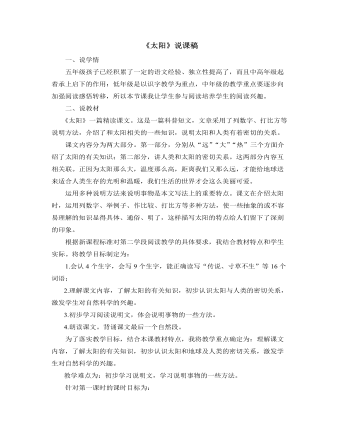
部编人教版五年级上册《太阳》说课稿
三、 说教法这是一篇说明文,它不是借助艺术形象传授知识的,而是在观察某些事物的基础上用准确、通俗的语言来说明事物传授知识的。所以我侧重以下几个方面来教的:1.抓住说明文的构段特点进行教学。教给学生学习方法,找出说明文在结构上注重一段一意,段首概括的规律,注重帮助学生理清文章的结构层次。2.抓住文中的语言,了解说明事物的方法。课文第一自然段为了讲清楚太阳的三个特点,运用了大量的数字来说明,给学生的感觉一目了然。但是为什么要引用传说,就是为了增加文章的生动性,这样教学既使学生了解了学法,又激发了学生学习兴趣。这样做的目的是,既教了课文,又学会了作者的写作方法。3.利用多媒体手段,激发学生的学习兴趣。说明文同记叙文相比,语言比较枯燥,形象性不强。在教学过程中,我制作了课件,变抽象为具体,激发学生主动学习的积极性,调动学生多种感官去接受知识,从而增强学习效果,是一举多得的方法。
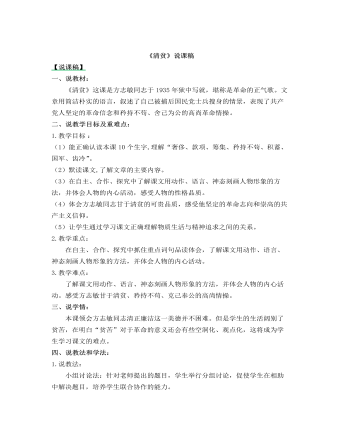
部编人教版五年级下册《清贫》说课稿
三、说学情:本课领会方志敏同志清正廉洁这一美德并不困难。但是学生的生活阔别了贫苦,在明白“贫苦”对于革命的意义还会有些空洞化、观点化,这将成为学生学习课文的难点。四、说教法和学法:1.说教法:小组讨论法:针对老师提出的题目,学生举行分组讨论,促使学生在相助中解决题目,培养学生联合协作的能力。朗读感悟法:朗读是一种非常重要的教学要领,课文中方志敏与“士兵”的对话内容以及感情变革写得非常好,很得当,分脚色朗读,在朗读中感觉方志敏同道甘于贫苦、矜持不苟的崇高革命情操。2.说学法:高年级的学生应注意培养学生的自学本领,送还学生自主学习权,我引导学生利用以下要领进行学习:自主探究法、分析归纳法、总结反思法。通过题目导学、学法引导、知识总结等引导学生在课堂上积极学习。
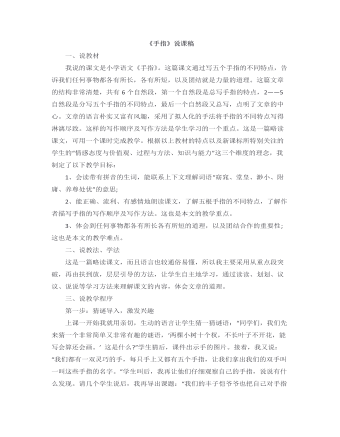
部编人教版五年级下册《手指》说课稿
非常清楚,共有6个自然段,第一个自然段是总写手指的特点,2——5自然段是分写五个手指的不同特点,最后一个自然段又总写,点明了文章的中心。文章的语言朴实又富有风趣,采用了拟人化的手法将手指的不同特点写得淋漓尽致。这样的写作顺序及写作方法是学生学习的一个重点。这是一篇略读课文,可用一个课时完成教学。根据以上教材的特点以及新课标所特别关注的学生的“情感态度与价值观、过程与方法、知识与能力”这三个维度的理念,我制定了以下教学目标:1、会读带有拼音的生词,能联系上下文理解词语“窈窕、堂皇、渺小、附庸、养尊处优”的意思;2、能正确、流利、有感情地朗读课文,了解五根手指的不同特点,了解作者描写手指的写作顺序及写作方法。这也是本文的教学重点。3、体会到任何事物都各有所长各有所短的道理,以及团结合作的重要性;这也是本文的教学难点。
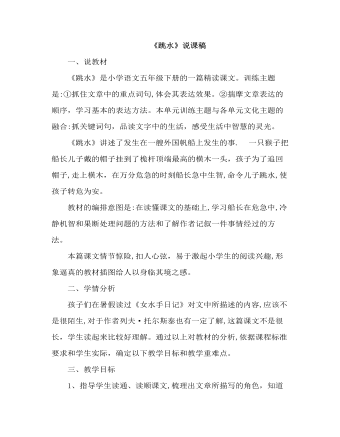
部编人教版五年级下册《跳水》说课稿
一、说教材《跳水》是小学语文五年级下册的一篇精读课文。训练主题是:①抓住文章中的重点词句,体会其表达效果。②揣摩文章表达的顺序,学习基本的表达方法。本单元训练主题与各单元文化主题的融合:抓关键词句,品读文字中的生活,感受生活中智慧的灵光。《跳水》讲述了发生在一艘外国帆船上发生的事. 一只猴子把船长儿子戴的帽子挂到了桅杆顶端最高的横木一头,孩子为了追回帽子,走上橫木,在万分危急的时刻船长急中生智,命令儿子跳水,使孩子转危为安。教材的编排意图是:在读懂课文的基础上,学习船长在危急中,冷静机智和果断处理问题的方法和了解作者记叙一件事情经过的方法。本篇课文情节惊险,扣人心弦,易于激起小学生的阅读兴趣,形象逼真的教材插图给人以身临其境之感。
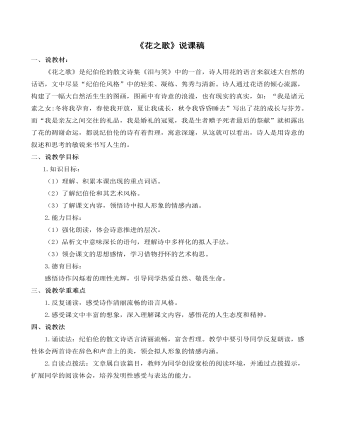
部编人教版六年级上册《花之歌》说课稿
一、说教材: 《花之歌》是纪伯伦的散文诗集《泪与笑》中的一首,诗人用花的语言来叙述大自然的话语,文中尽显“纪伯伦风格”中的轻柔、凝练、隽秀与清新。诗人通过花语的倾心流露,构建了一幅大自然活生生的图画,图画中有诗意的浪漫,也有现实的真实,如:“我是诸元素之女:冬将我孕育,春使我开放,夏让我成长,秋令我昏昏睡去”写出了花的成长与芬芳。而“我是亲友之间交往的礼品,我是婚礼的冠冕,我是生者赠予死者最后的祭献”就袒露出了花的凋谢命运,都说纪伯伦的诗有着哲理,寓意深邃,从这就可以看出,诗人是用诗意的叙述和思考的敏锐来书写人生的。 二、说教学目标 1.知识目标: (1)理解、积累本课出现的重点词语。 (2)了解纪伯伦和其艺术风格。 (3)了解课文内容,领悟诗中拟人形象的情感内涵。
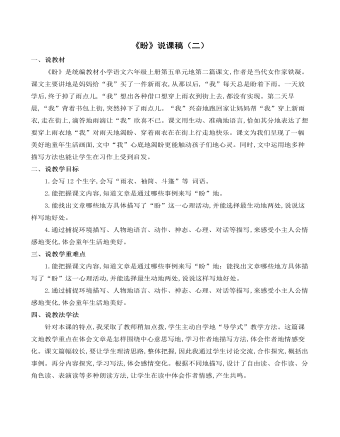
部编人教版六年级上册《盼》说课稿(二)
一、说教材 《盼》是统编教材小学语文六年级上册第五单元地第二篇课文,作者是当代女作家铁凝。课文主要讲地是妈妈给“我”买了一件新雨衣,从那以后,“我”每天总是盼着下雨。一天放学后,终于掉了雨点儿,“我”想出各种借口想穿上雨衣到街上去,都没有实现。第二天早晨,“我”背着书包上街,突然掉下了雨点儿。“我”兴奋地跑回家让妈妈帮“我”穿上新雨衣,走在街上,滴答地雨滴让“我”欣喜不已。课文用生动、准确地语言,恰如其分地表达了想要穿上雨衣地“我”对雨天地渴盼、穿着雨衣在在街上行走地快乐。课文为我们呈现了一幅美好地童年生活画面,文中“我”心底地渴盼更能触动孩子们地心灵。同时,文中运用地多种描写方法也能让学生在习作上受到启发。 二、说教学目标 1.会写12个生字,会写“雨衣、袖筒、斗篷”等 词语。 2.能把握课文内容,知道文章是通过哪些事例来写“盼”地。

部编人教版六年级上册《盼》说课稿(一)
【教材分析】《盼》是六年级第五单元的一篇课文。本文选自作家铁凝的第一本出版小说《夜路》,是一篇儿童文学类的小说。作者以孩子的视角,记述了得到新雨衣,渴望下雨到愿望实现——在雨中穿上了新雨衣的故事。用细腻的语言描述了小主人公情感和心理的变化,表现了童真童趣。【教学目标】1.疏通重难点字词的读音和写法。2.整体感知课文内容,把握故事情节,理清行文思路,感受小主人公因新雨衣而产生的“盼”。3.通过捕捉环境描写、人物的语言、动作、神态、对话等描写,来感受小主人公情感的变化。【教学重难点】通过捕捉环境描写、人物的语言、动作、神态、对话等描写,来感受小主人公情感的变化。【教学过程】核心问题:作者如何围绕一个“盼”字展开描写,表现小主人公的情感变化?

新人教版高中英语必修3Unit 1 Festivals and celebrations-Discovering Useful Structure教学设计
4.That was an experience that frightened everyone. →That was _____________________. 答案:1. taking 2. being discussed 3. in the reading room 4. a frightening experienceStep 6 The meaning and function of V-ing as the predicative动词-ing形式作表语,它通常位于系动词后面,用以说明主语“是什么”或“怎么样”一种表示主语的特质、特征和状态, 其作用相当于形容词; 另一种具体说明主语的内容, 即主语等同于表语, 两者可互换。The music they are playing sounds so exciting. 他们演奏的音乐听起来令人激动。The result is disappointing. 结果令人失望。Our job is playing all kinds of music. 我们的工作就是演奏各种音乐。Seeing is believing. 眼见为实。Step 7 Practice1. It is ________(amaze) that the boy is able to solve the problem so quickly.2. Buying a car is simply _______(waste) money. 3. Please stop making the noise—it’s getting ________(annoy). 4. complete the passage with the appropriate -ing form.La Tomatina is a festival that takes place in the Spanish town Bunol every August. I think many food festivals are __________ because people are just eating. however, this festival is _________ because people don't actually eat the tomatoes. Instead, they throw them at each other! the number of people ________ part in this tomato fight, can reach up to 20,000, and it is a very __________ fight that lasts for a whole hour. The _______ thing is how clean Bunol is after the tomatoes are washed away after the fight. this is because the juice form tomatoes is really good for making surfaces clean!答案:1. amazing 2. wasting 3. annoying4. boring interesting taking exciting amazing

新人教版高中英语必修3Unit 1 Festivals and Celebrations-Listening &Speaking&Talking教学设计
The theme of this section is “Talk about festival activities and festival experiences”.Festival and holiday is a relaxing and interesting topic for students. This part talks about the topic from the daily life of students’. In the part A ---Listening and Speaking, there are three conversations among different speakers from three countries(Japan, Rio and China), where the speakers are participating in or going to participate in the festivals and celebrations. So listening for the relationship among them is a fundamental task. Actually, with the globalization and more international communication, it is normal for Chinese or foreigners to witness different festivals and celebrations in or out of China. In the Conversation 1, a foreign reporter is interviewing a Japanese young girl who just had participated in the ceremony of the Coming-of-Age Day on the street and asking her feeling about the ceremony and the afterwards activities. Conversation 2, Chinese girl Li Mei is witnessing the Rio Carnival for the first time, and her friend Carla gives her some advice on the costumes which enables her to match with the carnival to have a good time. Conversation 3, a Chinese guide is showing a group of foreign visitors around the Lantern Festival and introducing the customs of the festival to them. The three conversations have a strong vitality and insert the festival and cultural elements from different countries. So perceiving the festivals and cultures from different countries is the second task. At the same time, the scripts also insert the targeted grammar --- v-ing as attributive and predicative, which students can perceive and experience in a real context and make a road for the further study. That is the third task. In the Part B--- Listening and Talking, the theme is “Talk about festival experience”, which is the common topic in our daily conversations. During the conversation, Song Lin, a Chinese student, asked Canadian friend Max about how to spend Christmas. In the conversation, Song Lin talked about experience and the feelings during the Chinese Spring Festival, during which there are not only some enjoyable things but some unpleasant things. After the listening, perhaps students find there are some similarities between Christmas and the Chinese Spring Festival as there are some differences in the origins and celebrations. For example, people always visit friends and relatives, decorate their houses, have a big dinner together, chat and give presents to each other.

新人教版高中英语必修3Unit 1 Festivals and Celebrations-Reading for Writing教学设计一
The topic of this part is “Write about your festival experience”.During the Listening and Speaking and Talking, students are just asked to say out their festival experiences such as the Spring Festival, Mid-autumn Day, but this part students will be asked to write down their own festival experiences. During the reading part, it introduces the Naadam Festival in Inner Mongolia Autonomous Region, which can give students a good example to imitate. Students not only learn the festival, but touch and feel the Inner Mongolian’s character, the spirit and cultural atmosphere, which can help students form the cultural awareness and learn to enjoy and value the diversity of Chinese culture.Concretely, the dairy tells the experience that the author spent the Naadam Festival in Inner Mongolia Autonomous Region with his/her friend. The structure is clear. In the opening paragraph, it introduces the topic of the Naadam Festival and the whole feeling. Then it introduces the items of the festival like the ceremony, wrestling and horse racing. Finally, it summarizes this experience. Because this part is a travel journal, we must guide students pay more attention to these details: 1. use the first person. 2. use the past tense to tell the past thing and use the present or future tense to describe the scenery. 3. use the timeline to tell the development. 4. be careful for the author’s psychology, emotion and feeling, etc.1. Read quickly to get main idea; read carefully to get the detailed information about Naadam Festival.2. Learn the structure of the reading article and language.3. Write an article about a festival experience4. Learn to use the psychology, emotions and feeling in the writing.1. Write an article about a festival experience.2. Use the structure of the reading article and language.

新人教版高中英语必修3Unit 2 Morals and Virtues-Listening &Speaking&Talking教学设计
Example:One day, a poor boy who was trying to pay his way through school by sending newspapers door to door found that he only had one dime(一角)left. He was so hungry that he decided to beg for a meal at the next house.However, he lost his nerve when a lovely young woman opened the door. Instead of a meal he asked for a drink of water. She thought he looked hungry so she brought him a large glass of milk. He drank it slowly, and then asked, “How much do I owe you?” “You don’t owe me anything,” she replied, “Mother has taught me never to accept pay for a kindness.” “Then I thank you from the bottom of my heart.” With these words, Howard Kelly left that house.Years later the woman became badly ill and was finally sent to the hospital in a big city. Dr. Howard Kelly, now famous, was called in. When he heard the name of the town she came from, a strange light filled his eyes. Dressed in his doctor’s clothes, Dr. Kelly went into her room and recognized her at once. From that day on, he gave special attention to her, and decided to do his best to save her life.At last the woman was saved. Dr. Kelly asked the business office to pass the final bill to him. He looked at it and then wrote something on the side. The bill was sent to the woman’s room. She was afraid to open it because she was sure that it would take the rest of her life to pay for it off. Finally she looked, and the note on the side of the bill caught her attention. She read these words: “Paid in full with a glass of milk, Dr. Howard Kelly.” Tear of joy flooded her eyes.

新人教版高中英语必修3Unit 2 Morals and Virtues-Reading and Thinking教学设计
The topic of this part is “Learn to make choices in life”.The Listening & Speaking & Talking part aims at the moral dilemmas, and this part is about making choices in life. The heroin is Lin Qiaozhi, a famous medical scientist, made a great contribution to our country’s medical care. Most importantly, her life experience can inspire our students whether in studying or the development of career. she had moral dilemmas and life choices, which are similar to the students who will step into society. Besides, Lin has quite good virtues like kindness, self-improvement, insistence, job-loving , generosity and responsibility, which is worth being learned.Concretely, this article is a biography about Lin Qiaozhi. The article tells her whole life according the timeline, among which the life choices is emphasized. For example, whether married or chased her dream, returned home or stayed abroad, family or public, her choices all reflected her faith, spirit, responsibility and devotion.1. Fast reading to get the detailed information about Lin Qiaozhi; careful reading to do the deductive information.2. Learn the reading skills--deductive judgement according the context.3. Study the structure features and language features. 4. Communicate about Lin’s life choices and reflect their own life choices.1. Learn the reading skills--deductive judgement according the context.2. Study the structure features and language features.3. Communicate about Lin’s life choices and reflect their own life choices.Step 1 Lead in---Small talkWhat are some important life choices?Importance choices: university study, jobs and marriage partners. Because they can determine our future.

